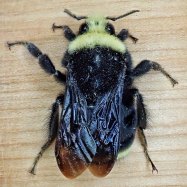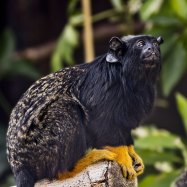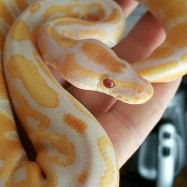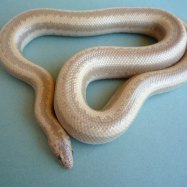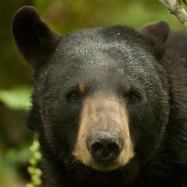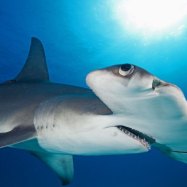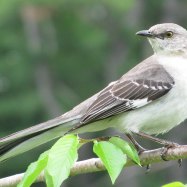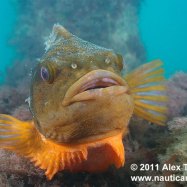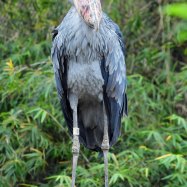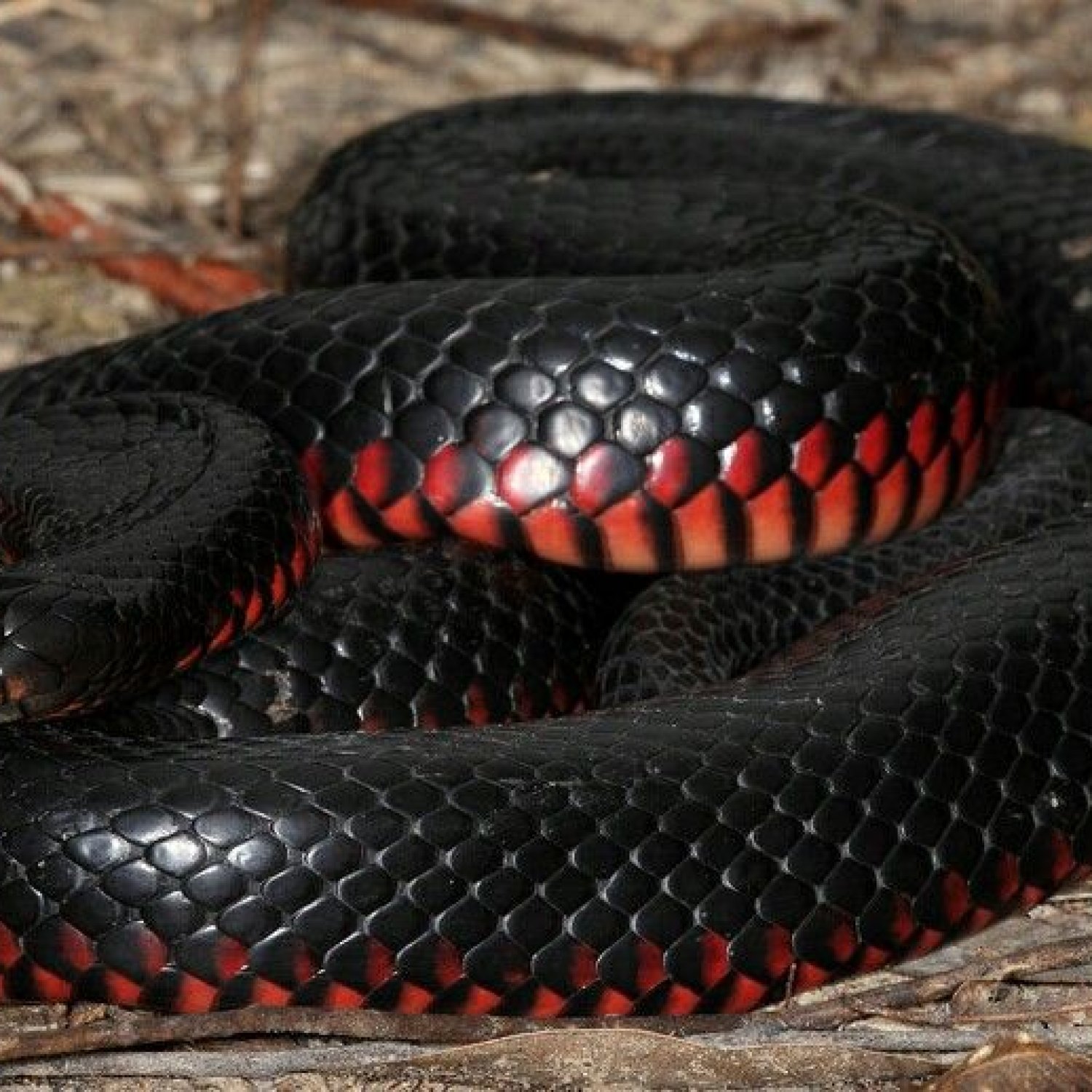
Red Bellied Black Snake
1.5 to 2.5 meters
The Red Bellied Black Snake, commonly found in Eastern Australia, can grow up to 2.5 meters long with its distinct red belly. Belonging to the Elapidae family, its long and slender body makes it a fast and agile predator. Stay cautious when hiking in its habitat and admire this beautiful snake from a safe distance. #AustralianWildlife #SnakeLover
Animal Details Summary:
Common Name: Red Bellied Black Snake
Kingdom: Animalia
Habitat: Woodlands, forests, wetlands, and coastal areas
A Closer Look at the Red Bellied Black Snake: A Deadly Beauty of Eastern Australia
Amidst the lush forests, wetlands, and coastal areas of Eastern Australia, a creature quietly slithers through the undergrowth. With its long and slender body, adorned with striking black and red coloration, the Red Bellied Black Snake (Pseudechis porphyriacus) is a sight to behold. But don't let its beauty deceive you, for this serpent is known to be one of the most dangerous snakes in Australia.As the scientific name suggests, the Red Bellied Black Snake belongs to the kingdom Animalia, with a classification of Chordata in the reptilian class Reptilia Red Bellied Black Snake. Its order, Squamata, is shared by other snakes and lizards, making it a close relative of various species. However, it belongs to the family Elapidae, known for its venomous snakes such as cobras and taipans. This deadly serpent is found in abundance in Eastern Australia, making it the most common elapid in the region.
The Red Bellied Black Snake's habitat includes woodlands, forests, wetlands, and coastal areas, giving it a diverse range of environments to thrive in. This species is most active during the warmer months, from September to May, and can be found basking in the sun or hunting for prey. Like most snakes, it is a carnivorous predator, feeding mainly on small mammals, birds, and reptiles. Its ability to consume other dangerous creatures, such as venomous spiders, makes it a vital member of the ecosystem.
One of the most distinctive features of the Red Bellied Black Snake is its coloration. As the name suggests, its body is predominantly black, with a bright red underbelly that stretches from the throat to the tail Red Kite. This unique coloration acts as a warning signal to potential predators, stating that it is a venomous species and best to be avoided.
The elegant body of this snake is long and slender, reaching lengths of 1.5 to 2.5 meters. Their shiny black scales provide excellent protection against predators and make them highly efficient hunters. Some individuals may have a white or cream-colored stripe on the side of their body, adding to their striking appearance.
The Red Bellied Black Snake is an oviparous species, meaning they lay eggs. The females lay a clutch of around 5 to 12 eggs, which hatch after approximately ten weeks. The hatchlings are about 30 centimeters long and are immediately independent, receiving no parental care from their mother. This reproductive strategy ensures that the population stays stable, and the species continues to thrive in its natural habitat.
With its widespread presence in Eastern Australia, the Red Bellied Black Snake is deeply rooted in Australian culture and folklore. It has made appearances in various forms of media, including books, movies, and music. But despite its presence in popular culture, the species has a somewhat negative reputation due to its deadly venom.
As a member of the Elapidae family, the Red Bellied Black Snake possesses potent venom, which it uses to incapacitate its prey. The venom is made up of a combination of neurotoxins and myotoxins, causing paralysis and tissue damage in its victims. However, since these snakes are shy and reclusive, they will only resort to using their venom as a last resort for self-defense if they feel threatened. In most cases, the snake will retreat or give a warning display before striking.
But if a bite from this serpent does occur, it can have severe consequences. Without proper medical treatment, the venom can cause muscle paralysis, breathing difficulties, and even death. It is essential to seek medical attention immediately if bitten by a Red Bellied Black Snake.
Despite its reputation as a dangerous creature, there have been very few fatalities recorded due to its bite. This can be attributed to the availability of antivenom and the snake's non-aggressive nature. In fact, the Red Bellied Black Snake plays a vital role in keeping the ecosystem in balance by controlling the population of small rodents and other pests.
In recent years, the Red Bellied Black Snake population has remained stable, and the species is listed as least concern on the International Union for Conservation of Nature (IUCN) Red List. However, like most wildlife, it faces threats such as habitat loss, roadkill, and human persecution. It is essential to educate people about snakes and their importance in the ecosystem to ensure their continued survival.
In conclusion, the Red Bellied Black Snake is truly a marvel of nature. Its striking appearance, deadly venom, and importance in the ecosystem make it a fascinating animal to study. While their reputation may precede them, these snakes play a crucial role in maintaining the balance of life in Eastern Australia. So the next time you come across a Red Bellied Black Snake, admire its beauty from a distance, and remember to respect these creatures for their integral role in our natural world.

Red Bellied Black Snake
Animal Details Red Bellied Black Snake - Scientific Name: Pseudechis porphyriacus
- Category: Animals R
- Scientific Name: Pseudechis porphyriacus
- Common Name: Red Bellied Black Snake
- Kingdom: Animalia
- Phylum: Chordata
- Class: Reptilia
- Order: Squamata
- Family: Elapidae
- Habitat: Woodlands, forests, wetlands, and coastal areas
- Feeding Method: Carnivorous
- Geographical Distribution: Eastern Australia
- Country of Origin: Australia
- Location: Eastern Australia
- Animal Coloration: Black with a red belly
- Body Shape: Long and slender
- Length: 1.5 to 2.5 meters

Red Bellied Black Snake
- Adult Size: Up to 2.5 meters
- Average Lifespan: 10 to 15 years
- Reproduction: Oviparous
- Reproductive Behavior: Mating occurs in spring and summer
- Sound or Call: Hissing sound when threatened
- Migration Pattern: Non-migratory
- Social Groups: Solitary
- Behavior: Mainly diurnal, active during warm weather
- Threats: Habitat loss and fragmentation, predation
- Conservation Status: Least Concern
- Impact on Ecosystem: Controls population of small mammals and reptiles
- Human Use: Not used by humans
- Distinctive Features: Red belly, venomous
- Interesting Facts: The venom of the Red Bellied Black Snake is not often fatal to humans
- Predator: Birds of prey, larger snakes

Pseudechis porphyriacus
The Red Bellied Black Snake: A Fascinating Creature of the Australian Outback
Australia is known for its diverse and unique wildlife, and among its many fascinating creatures is the Red Bellied Black Snake. This strikingly beautiful snake is not only a prominent inhabitant of the Australian outback, but it also holds a special place in Indigenous Australian culture. In this article, we will delve into the life of the Red Bellied Black Snake and uncover the many fascinating facts and features that make it a truly remarkable creature.A Mighty Predator
The Red Bellied Black Snake, scientifically known as Pseudechis porphyriacus, is a large and powerful snake that can reach up to 2 PeaceOfAnimals.Com.5 meters in length. With its jet black body and distinctive red belly, it is easily recognizable and often feared by humans. However, this snake is not as dangerous as it may seem – while it is venomous, its venom is not often fatal to humans.As a predator, the Red Bellied Black Snake plays a crucial role in maintaining the balance of its ecosystem. It mainly feeds on small mammals and reptiles, such as rats, mice, lizards, and other snakes. Its powerful venom allows it to quickly immobilize and digest its prey, making it an efficient predator in the harsh Australian outback.
Reproduction and Behavior
The Red Bellied Black Snake is an oviparous species, meaning that it reproduces by laying eggs. Mating occurs during the spring and summer months, and females can lay up to 20 eggs at a time. These eggs are then left to incubate in a secluded location, and the female plays no further role in the development of her offspring Red Tail Boa.While the Red Bellied Black Snake is mainly solitary, it is not uncommon to find them in small colonies or groups during the breeding season. They are also primarily diurnal, meaning they are most active during the day, especially in warm weather. However, they may also be seen basking in the sun during cooler weather to regulate their body temperature.
Threats and Conservation
Like many other wildlife species, the Red Bellied Black Snake faces threats to its survival, primarily due to habitat loss and fragmentation. As humans continue to expand into its natural habitat, the snake's food sources and nesting sites become scarce, resulting in a decline in its population.Thankfully, due to its wide distribution and adaptability, the Red Bellied Black Snake is currently listed as Least Concern on the International Union for Conservation of Nature's Red List of Threatened Species. However, conservation efforts, such as preserving and restoring its habitat, are crucial in ensuring its continued survival.
A Symbol of Hope and Protection
Aside from its ecological role, the Red Bellied Black Snake also holds cultural significance among Indigenous Australians. In Aboriginal Dreamtime stories, it is often depicted as a powerful symbol of protection and guidance, and its distinctive red belly is said to represent the blood of the land.It is not uncommon to see artwork and totems featuring the snake, and in some Indigenous communities, it is believed that the snake's presence is a sign of good luck and prosperity. This cultural significance further emphasizes the importance of preserving and protecting this magnificent creature.
Interesting Facts about the Red Bellied Black Snake
While the Red Bellied Black Snake may seem intimidating, there is much more to this fascinating creature than meets the eye. Here are some interesting facts that you may not know about this species:- The Red Bellied Black Snake is a non-migratory species, meaning it stays within its home range and does not travel long distances. It can be found in various habitats, including forests, woodlands, wetlands, and coastal areas.
- Despite its venomous nature, the Red Bellied Black Snake is usually not aggressive towards humans. It will only strike if it feels threatened or is provoked.
- The snake makes a distinctive hissing sound when it feels threatened, but it is also known to make a clicking sound by rubbing its coils together. This behavior is believed to be a form of communication with other snakes.
- The Red Bellied Black Snake is a great swimmer and is often found near water sources. It can swim with its head lifted above water, allowing it to breathe while moving.
- While its venom is not often fatal to humans, it can still cause serious pain and discomfort. The good news is that antivenom is readily available, making it possible to save the lives of those bitten by this snake.
Nature's Wondrous Creatures
The Red Bellied Black Snake is a true marvel of nature, with its striking appearance, impressive size, and essential role in its ecosystem. It is a reminder of the incredible diversity and beauty of the natural world and the importance of preserving and protecting these creatures for future generations.So, the next time you come across a Red Bellied Black Snake while trekking through the Australian outback, remember to admire it from a safe distance and appreciate it for the remarkable creature that it is.
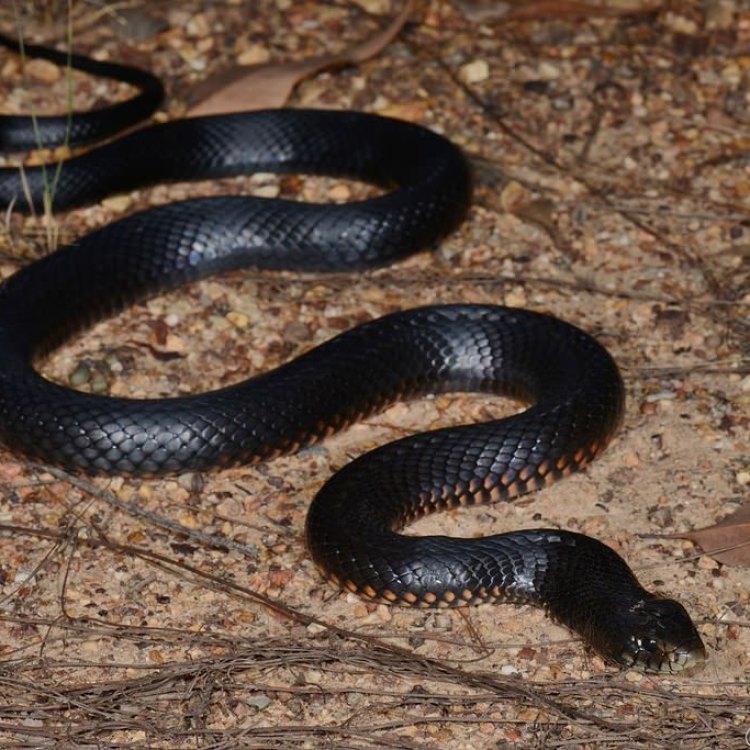
A Closer Look at the Red Bellied Black Snake: A Deadly Beauty of Eastern Australia
Disclaimer: The content provided is for informational purposes only. We cannot guarantee the accuracy of the information on this page 100%. All information provided here may change without prior notice.

